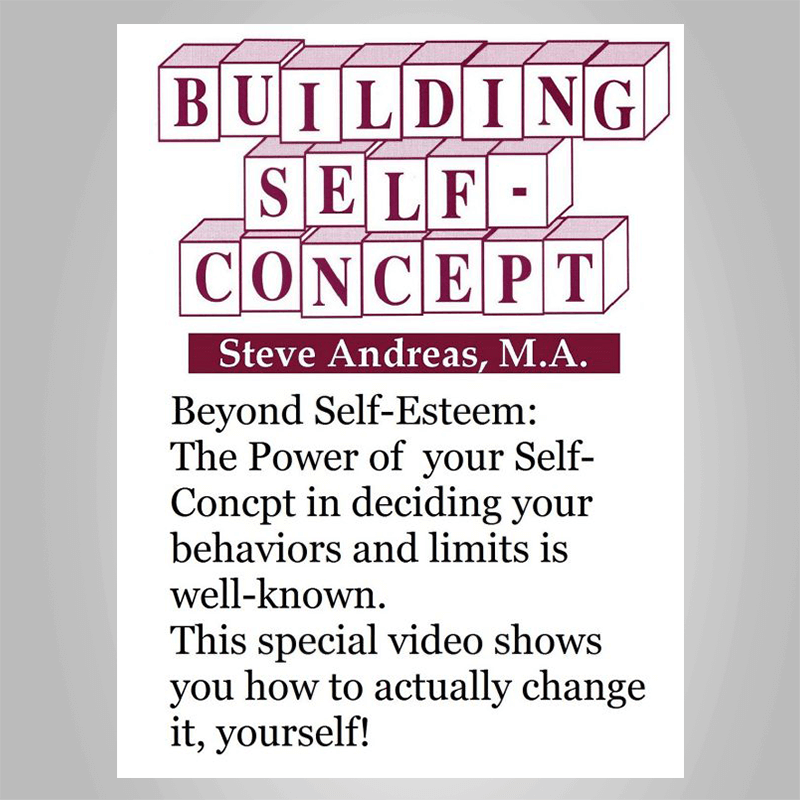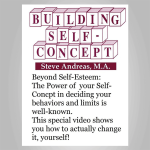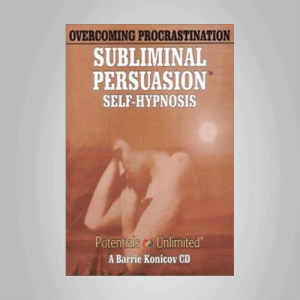Steve Andreas – Building Self ConceptWe have been exploring the impact and the interaction of both process and content variables in making a quality of your self-concept durable and responsive to feedback. We have also explored the importance of integrating counterexamples, and how to transform counterexamples into examples. With what you have learned, you could ask someone about any important quality of their self-concept, ask them questions to find out how they already do it, and then teach them a variety of additional skills so that their self-concept functions much better than it already does. Making this kind of change will reverberate throughout their life, affecting many specific behaviors and responses.Now it’s time to demonstrate how to use all this information to do something even more useful and generative, namely to create a whole new positive quality of self-concept when a person has no representation of this quality.When someone thinks of themselves as having a certain quality, such as being lovable, that indicates that they have a positive self-concept with regard to that quality. Since they have this basis for inner knowing, they don’t need others to tell them, and when others express their recognition of it, they can fully appreciate the additional confirmation.When someone says, “I’m unlovable,†that indicates that they think of themselves as not lovable, a negative self-concept with regard to that quality, something that we will explore in considerable detail later. If we were to try to build a positive self-concept for that quality, it would be very difficult, because this would conflict with the negative self-concept that is already there. And if we did succeed in building a new positive quality, that would create ambivalence and uncertainty. Some people are already ambivalent in this way. Sometimes they feel lovable, sometimes they don’t, and often they are just unsure.When someone says, “I don’t think of myself as lovable,†we need more information to know what their inner experience is. They could be saying that they have a negative self-concept. Or they could mean what the words literally say–simply that they don’t have a positive self-concept (or a negative one) with regard to that quality. They presumably know what the word “lovable†means, but they have not assembled experiences (either positive or negative) that provide any information about whether they are lovable or not. For convenience I will call this absence of a database a “null set.â€Since they don’t know if they are lovable or not, they typically often ask others for confirmation. But even when they get this support from others, it doesn’t last very long, because they don’t have a way to store this information. Hearing the external confirmation is like receiving water in a sieve–it goes right through and disappears. So they are likely to ask again soon, and are often described by others as “insecure,†“needy,†or “dependent.â€In this case it is appropriate to simply assemble experiences into a desired quality of positive self-concept, a method that was first described years ago. (See the book, Heart of the Mind, Ch. 3). Since often someone already has an ambiguous or negative representation of the quality, the opportunities for using this pattern are somewhat limited. However, for teaching purposes it is useful to start with the simplest case, in which there is no negation or ambivalence to deal with, and we can simply use what we have learned to build a new quality of self-concept. Soon we will go on to learn how to transform an ambivalent or negative quality of self-concept into a positive one.The verbatim transcript that follows is of a demonstration from an NLP Master Practitioner Training conducted in 1992, and is available on DVD (Building Self Concept, Steve Andreas). At that time I was still in the process of modeling self-concept, so I knew much less than you do now. I had made a brief introductory presentation much like the foregoing, and when I asked for a volunteer for a demonstration of this process, Peter raised his hand.DemonstrationAnd what is it that you’d like to–? (build)Peter: Well, “lovable†really hit a chord.OK, you don’t think of yourself as lovable.Peter: Not particularly.think of you as lovable, so come on up. (Peter comes to the front of the room.) OK, now when I said that, what did you do inside?Peter: (shaking his head and shrugging) I sort of went, “Nope.â€Now, if you go “Nopeâ€â€“give me some more. (to the group) See, I’m testing to make sure it’s not one of these (negatives).Peter: Well, it sort of hits a– I get a sense that it hits a blank.“A blank.†OK. That sounds good. Because if it’s one of these (null sets), then it’s like there’s just nothing there. It’s not that there is a negation. And as I experience you, I don’t– I wouldn’t think that you think of yourself as unlovable.Peter: Not really, no. It’s more– I don’t think of myself as unlovable; I don’t think of myself as lovable.Yeah. That’s good. (to the group) That’s what we want. Does it make sense that I’m testing a little bit here? Because I want to make sure it’s one of these (null sets). What happens if you just go ahead and build one of these (positives) and you don’t weaken one of these (negatives)?. . . Think about it. Now . . . I’m serious. This is an important point. If someone has a negative belief–If he thought he was unlovable, and I build a belief in here that he is lovable, now what? . . . Now you’ve got a parts problem. Most people have enough conflict as it is; let’s not build in more. (to Peter) Think of something that you do believe is true of yourself.Peter: (nodding) I think I’m intelligent.Intelligent. Good. And you’re pretty sure of that, right?Peter: (nodding) Yeah. (laughter)Yeah. (joking) Now we didn’t say, “arrogant,†we said, “intelligent.†(more laughter) OK. Now, what I’d like to know is, what is your evidence? How do you represent this sense of yourself as being intelligent?Peter: Hmmm. . . . Umm, (laughs) I’m not really sure. Um, it’s sort of like it’s so built into me? . . . (gesturing toward his left ear) I have a voice that tells me that “I’m smart.â€So there’s a little voice over here. Now, what is its evidence? See, a voice is just a voice, right? So there’s a voice on your left that says “I’m smart.†OK. And that’s fine; I’m not disagreeing with that. I just want to know what is its evidence? How does it know that that’s the case?Peter: Other people have told me.Well, I don’t trust other people. Do you?Peter: (nodding) Yes.You do? So all I have to do is tell you that you’re lovable, and from now on–Peter: I guess if I hear it enough.“Enough.†OK. And so–Peter: Yeah. Now that kind of fits. Because that’s what you were saying–like I’m always wanting my wife to tell me how much she loves me. And her experience is that that’s really excessive. (laughter)Yeah. (laughter) (to the group) This is what we want. This is what we want. We’ve got it both ways, because the two major tests have just been fulfilled. The one is that he tends to go for confirmation from others, and the other is that if I tell him he’s lovable it’s like it doesn’t compute. It’s like, “Well, uh, it’s like there’s a blank.†And that’s what we want. OK, great. (to Peter) Now, in terms of “I’m smart,†do you have an auditory memory of lots of different people saying that, in a lot of different contexts? Is that the evidence?Peter: (nodding) Yeah, and um, I’ve done a lot of things that I got external confirmation.So, as you hear these–let’s just take one–can you think of a particular one, where someone says, “You said something intelligently,†or something like that? Or whatever?Peter: (nodding)An auditory remembered– So what kind of thing might it say?Peter: I remember my father saying, “I can’t imagine where you got all this intelligence from.â€Oh, that’s nice. Do you hear it? It’s presupposed. “I can’t imagine where you got all this intelligence from.†There is also an implied comparison, isn’t there–that he’s not that smart. Peter is saying that his father told him that he was smarter than his father.Peter: That created lots of strange stuff inside me, because I had always believed he was a lot smarter than me. So that was a real–(Peter looks amazed).When he said that. Got it, OK. (to the group) I’m just going to jot this down, because I want to remember it. Sometimes you get a good one like this, and it’s just wonderful for teaching. “I can’t imagine where you got all this intelligence from.†That’s a good one. I wish more parents did that. What would most parents say? . . . Keeping the same form of the sentence, and just changing a few things? What would most parents say? “How’d you get to be so stupid, obstinate.†“I don’t know where you got all that stupidity from.†OK, well, let’s not dwell on that. (to Peter) And are there others? Can you hear other voices in there? And what I hear from you is that it’s important whose voice it is. Is that right?Peter: (nodding) Yeah.If this were just a man in the street, would it matter as much? Would it be as compelling?Peter: It wouldn’t be as compelling; it would still–it would still compute.So it would still be part of it. OK. Good.Peter: The more intelligent the person is who’s noticing, the more impact it has.Sure. So the source is important. OK. How many voices in there do you have, do you think? You said you had a bunch of them, remembered, people–Peter: (shaking his head) I don’t know, but a number came to mind of fifty.Fifty. OK. This is a thorough person, right?Peter: I guess so.Good. All right. Now, anything else in terms of the evidence? There’s this voice that gives you the message, and there’s the evidence behind that, of all these different people, saying this kind of thing. Anything else?Peter: Umhm. There’s– When you first asked the question I didn’t have anything–any pictures particularly. It was more an auditory thing. As you’re asking me now, I can remember pictures of when I went and accepted my degrees, and I have certificates hanging on walls that let me know–And if you hear your father’s voice saying this sentence, “I don’t know where you got all that intelligence from,†is there some picture along with that?Peter: (shaking his head) Um, no. Just the picture of him–I mean, just him saying–I can remember the situation in which he said that.Well, yeah, but do you have that– Is this a voice crying in the wilderness or do you have some picture along with it of when he said it? (Peter is English, so it makes sense that his representation is primarily auditory, but I am checking to see if the visual is also present, which is usually more prominent for Americans.)Peter: (nodding) I think the auditory is much more important than the visual.Fine. Good. Now I’m going to ask you another question, which may seem a little strange. “Are there any counterexamples in there?†Are there any– ?Peter: (smiling broadly and shaking his head) No. In a way yes, and in a way, no. I mean I know that I sometimes do things that are kind of stupid, but (shaking his head) that doesn’t change the belief. For some reason it doesn’t have an impact.That’s fine. Now I want to do something–kind of an experiment, and you tell me how it goes. What if you have one voice in there–at least–let’s say one, or two, or three that says, “every once in a while you screw up.â€Peter: That’s fine.Is that fine? OK. Now what I’m doing here is something that–it’s a way to avoid pomposity. It’s wonderful to have generalizations, but all generalizations break down somewhere. Even the most intelligent person in the world–I don’t care who you choose–is going to say stupid things from time to time–or be stupid or act stupid, or whatever. If the person has only positive examples in their generalization, then they may think, “Everything I say is gold. Everything I do is perfect; everything I do is right.â€Peter: (shaking his head) Nope.(to the group) This is not (the case) here. OK. And one of the ways you can do that (protect against pomposity) is to deliberately build in counterexamples to the generalization. It’s wonderful to have a big solid generalization. He has fifty (examples); some people have one. There’s the old joke about the guy who knows that all Indians walk single-file, because he saw one once. (laughter)And this is a whole area that’s fascinating to explore, in terms of self-concept, and generalizations in general. Because the self-concept is simply a generalization about the self. Some people do make generalizations based on one example. A person does one thing, and they go, “Oh, that’s that kind of a person,†because they saw them once–it’s just like the “single-file,†really. And others are much more thorough, and they have to get a whole bunch of examples in order to build a generalization.Did you ever see someone who thought they were really, really intelligent and other people didn’t agree with them? Unfortunately clients don’t come in to you saying, “I’m just too pompous, and I’d like you to change that.†(laughter) They don’t. If a depressed person believes that nothing will work, he won’t come in to tell you about it, because (he thinks) that will not work either. So there are some loops that people can get into with certain kinds of problems, they will not bring themselves in. Somebody else may bring them in–a wife, or son, or daughter or someone else, but the person does not perceive it as a problem (or that a solution is possible).Most of the frames that we’ve had around the NLP that we’ve been teaching you is a voluntary client, somebody who comes in and says, “I’m hurting: my life is not working in this way; I want some help.†There are other things like this that are a little harder to deal with, because you have to kind of convince somebody that it’s a problem (or that a solution is possible).(to Peter) OK, back to this one now. What I propose to do–and I’d like to know if you have any objections–is to build the same kind of representation here that you’re lovable.Peter: (emphatically) No objections! A lot of voices are going inside “Yeah, yeah, yeah!â€And your wife will like it too. Now, you know where you hear these voices, and how loud, and the details for the “I’m smart†or “I’m intelligent.†And I want to do this in the following way, because I think it will work better. You have this–the major generalization is “I’m smart.†I want to build that (summary generalization) last. Before I do that, I want to build these other ones, specific examples in the past. It doesn’t have to be that you’re “lovableâ€â€“that word doesn’t have to be in there. It could be, you know, “You just did a very loving thing with that child,†or “That was a sweet gift you gave me,†or whatever. And I want you to take the time, one at a time, to build fifty of those. And when you have got fifty of them built, then you give me–then build this one, the major voice that lets you know “I’m lovable,†or “I’m a caring person,†or however you would like to say it. The words are not important, except to the individual, because some words will work better for an individual. Do you have any question about that?Peter: No.Go for it. (Peter closes his eyes.) Just search back through memory, . . . and of course your unconscious mind can participate fully in this, . . . to think of different times in your life . . . and just as it was important in the other one that the person was intelligent who said that you were intelligent . . . it would probably be important that the person who says these things . . . be a person who is intelligent, and lovable, or has something else that you respect along the same lines. Does that make sense? (Peter nods) OK. Just take your time. . . . Gradually assemble, one by one . . . voices that sincerely and congruently . . . give you appreciation for being a caring, lovable person. . . . (There is a 26-second pause, while Peter finds and assembles examples.)And I don’t think you really have to count to fifty.Peter: (in a softer voice, nodding) No, I was just getting a sense that the process is complete.So you have a sense of that being complete. You can also put in a few more in your spare time, too–when you’re waiting for a bus, or something like that. OK, now, have you already built the voice here that sort of summarizes all this?Peter: (nodding) Umhm. (softly) It says, “I am loved.â€â€œI am loved.†Good. That’s a good one. And I like the tone of voice, too.Peter: (smiling broadly) Yeah. I like that one, too.Now. Are you a lovable person?Peter: (softly) Yeah.How does that feel?Peter: (smiling) Very strange.Yeah. It will at first. It’s a new thing. It’s like a lot of changes that are strange at first, but it’s a nice strange, right?Peter: Yeah. It’s sort of thinking about myself in a whole different way. . . . Do I sound different?Uhuh. (group members agree.)Peter: Because even to me, my voice sounds different.Uhuh. It has more depth. It’s a little lower.Peter: Ooooh! (smiling broadly) Thank you.How does it feel now? Now that you’ve had all of twenty seconds to get used to it. (laughter)Peter: Um, it kinds of feels like there’s a whole bunch of bouncing around going on inside. And, um, it’s a little shaky. And I think I have a–the greatest thing is a sort of a feeling of total wonder. (softly) It’s like wow!* * * * *About three minutes later, Peter commented: “What I’m having the sense of now, as I was going back through time, was a whole bunch of events immediately sort of came out as, ‘Oh that’s an example of that,’ and ‘That’s another one,’ and ‘There’s another one.’â€That is a typical response as the new generalization becomes a nucleus for collecting other examples that fit the newly-organized quality. This session, including the teaching points with the group, took seventeen minutes.* * * * *Follow-up interview with Peter:The following is a verbatim transcript of an interview with Peter two weeks later, the day after Valentine’s Day.So it’s been a couple of weeks, Peter, since we did the thing on being lovable–or loved, as it came out to be, and I wondered if you had noticed any changes–and especially you had mentioned something I believe that you had kind of kept asking your wife if she loved you and stuff like that, or if she’s noticed anything.Peter: I’m not sure if she’s aware of what’s changed. I’m certainly aware of it, in that I feel a lot more independent. It’s like–exactly that–I don’t need that constant feedback. And the thing that was kind of interesting was–of course Valentine’s Day is a great time for this. And yesterday I got some really great Valentine’s gifts, a lot of them in a row, that really showed me clearly how much she does care about me. And that, in itself, was a difference, in that I really noticed. I mean like, it had an impact. Whereas before I’d sort of take this stuff and “Ahhh, well,†(Peter gestures with his left hand, as if casually throwing it away over his left shoulder) and it would sort of flow over my head (gesturing over his head).That’s a nice gesture. (laughter) (imitating) “Do you love me?†“Yes.†(copying Peter’s gesture) (laughter)Peter: (smiling and nodding) It’s not possible. Whsst. (Peter repeats the gesture) So now, I was really noticing all the extent and–You could really savor it, and experience it, rather than just discard it. (Peter nods.) Great.Peter: Yes. That was really nice. The other thing that came up, I did a presentation to a group of people yesterday that I think are probably not particularly open to the kind of thing that I had to say. And I was amazed at how well it went over, the positive response that I got back from them. It was a really positive feeling, and again, I’m not quite sure how that ties in, but I’ve got a sense that that’s involved. Like there’s something very different about what I’m putting out in situations, or what I’m allowing to come back in.Perhaps both.Peter: Yeah. So I’ve been great. I’m–I’m feeling it.* * * * *Follow-up interview with Peter’s wife.A week after the follow-up with Peter, I talked with Peter’s wife, Joan. At this time, Peter still had not told her anything about the work that I had done with him.Well, Joan, it’s about three weeks now since I did some work with your husband, Peter. One week ago I had a little follow-up interview with him, and I asked him if you had noticed any difference in his behavior, and he told me that he hadn’t asked you. So I guess he didn’t even tell you that I had done some work with him. Is that right?Joan: No, he didn’t tell me the process. I kind of asked him what–that, you know, I had noticed changes in him.Can you say what those changes are?Joan: Oh, well, it was amazing. What I’m doing now is going back to the first time he came through the door after three weeks ago. And I noticed right away that even physically there was a change. There was more bounce in his step. There was a lightness about him. His eyes were brighter. His face was not as tight; it was a lot more relaxed. His voice was softer. The changes that I’ve noticed behaviorally in how we interact–Yes, that’s particularly what I’d be interested to hear.Joan: He’s a lot more fun. He plays a lot more. He’s gentler on himself–not as goal-oriented.Can you think of any specific things that were different before and after, or something that happened during the last couple of weeks that he wouldn’t have done before, or anything like that?Joan: He listens.He listens?Joan: Listens. Instead of being as judgmental as before, like saying right/wrong stuff, it was like coming from a more loving and understanding place. . .where there was no right, no wrong. It was just listening to me.You like the changes.Joan: Oh, I love the changes! They’re wonderful. We interact a lot more in a fun way. He’s lighter, he’s happier–Nicer to be around.Joan: Oh, bubbly, like–yeah, a lot nicer to be around, I love that.Great. Is there anything else? Then I’ll tell you what we did.Joan: It’s like he–I keep wanting to say–it’s like he loves himself more, and everybody else more, is more able to play.It’s made a big difference.Joan: Oh, an incredible difference. Yeah, I really, you know, yeah!* * * * *In a discussion that followed this videotaped interview, Joan mentioned two other changes in Peter. One was that he had played for a long time with a child who was visiting, and that he had never done that before. She also said that Peter no longer worried if she wanted to do something on her own. If she were going to be away for the afternoon, he didn’t need to know where she was, and he didn’t need to call to find out when she was coming home.DiscussionDo you have any questions about this videotaped session?Fran: It just seems too easy and undramatic. Most people think that identity level change is very difficult and takes a long time.Well, anything is hard, if you don’t know what to do, or how to do it, and most things are easy when you do. Can you all think of an experience of using a new piece of equipment for the first time, and being frustrated and upset by not knowing how to use it? But as soon as you found out how, it was easy?What I demonstrated with Peter is the simplest kind of identity change. It was a change that he congruently wanted, there were no negative beliefs to get in the way, and there were no conflicting outcomes to satisfy.Most people who attempt to build a more positive sense of themselves find it very difficult because they already have a negative sense of themselves that gets in the way of this. That’s a little like trying to lift a big rock that is firmly attached to the ground, so of course it’s very difficult, and very dramatic.Soon I’ll teach you how to deal with those kinds of situations, but they do complicate the process somewhat.Many people equate a large show of emotion with effective change, and I think that is one reason why NLP has often been criticized for “leaving out the emotions.†There are plenty of counterexamples to the idea that drama and emotion is a sign of effectiveness, and I think that this idea is actually exactly backwards. Quite often when people are very emotional, they are simply expressing their frustration, and their lack of resources to deal with a difficult situation.In contrast, when your resources are adequate to cope with a difficult situation, you may not even think about it, much less become emotional about it! Think of tying your shoelaces, and all the other things that were insurmountable challenges for you as a small child, that are now so routine and unconscious that you don’t even think about them.Engineers know that any machine that makes a lot of noise is inefficient, because noise is a form of energy that is being wasted (unless the purpose of the machine is to make noise). An efficient machine is very quiet, because all its energy goes into carrying out its function.Many years ago, I used to do Gestalt Therapy, which has lots of drama–people screaming and yelling at empty chairs, and pounding pillows. It was very dramatic, but the results were seldom particularly useful. Before antibiotics or immunization, every family experienced many life and death dramas as their children struggled with diseases like scarlet fever and smallpox that are now virtually unknown. Antibiotics and immunization are very undramatic, and very effective. In nearly every field, when we know exactly what to do, change is easy, and very undramatic. Many of the changes you have already experienced were very undramatic, but they will have far-reaching consequences for you.Dan: What if someone can’t find examples of the quality that they want to have?That is usually a matter of how they are searching for them. Often when they can’t find any examples, their criteria are too high and perfectionistic. If they’re searching for examples of “courage,†they may think that word can only be exemplified by winning a small war single-handed. Or they may examine all their examples of courage, and find that none of them are quite perfect. In that case you need to loosen their criteria, and broaden their definition a bit, so that more of their memories will fit that word. Courage can mean a wide range of behaviors in which someone stands by their principles and values and bravely faces some kind of opposition. Once you have broadened their criteria a bit, most people can find plenty of examples.But let’s say that someone still couldn’t find any examples. In that case you could use all your skills to help them access appropriate resources and revise memories so that they were courageous in the past, and then future-pace them into the future, so that the person has future examples as well, and then use both for the database.Ann: Can you give an example of that?Sure. If they can’t find examples of courage, ask them to think of a time when they weren’t courageous and wanted to be. Then you ask them to review that situation and think of what personal resource would have made it easy for them to be courageous. Perhaps if they had simply thought at the time of the effect of this situation on their kids, or someone else, it would have been easy to take action. Then they can replay that situation with this larger frame in mind, running a movie of what they would have done differently until it’s what they want. Then put that experience into the future wherever they are likely to need it, and then put both the revised past example and the future example into a new database for courage.Or perhaps they were too concerned about other’s opinions of them. Then you could ask them for a time when they didn’t give a damn about someone else’s opinion, and when they are fully experiencing that feeling, have them rerun that situation, and see how it unfolds differently. They can do this kind of adjustment and testing as many times as they want until it is satisfactory, and then put this experience into the future, and into the database.Bill: I’m wondering if people might have different kinds of templates for different positive qualitiesI haven’t investigated that. What I demonstrated with Peter has always worked fine, so I have assumed that a person’s templates for different positive qualities are either the same, or else so similar that any differences don’t matter. I think it was Gregory Bateson who said that “A difference that makes no difference is no difference.†I have been most interested in the practical question of what people can do to change, but that would be an interesting thing to research, and you might discover something useful.Lois: I’m surprised that you didn’t give Peter more detailed instructions about what to do. It obviously worked fine, but I’d think he’d need more specific direction.This was in an NLP Master Practitioner Training, so I could presuppose that Peter already had a lot of advanced skills and understandings about submodalities and so on. If he had any difficulties, I would have made the instructions more detailed and step-by-step.Sometimes people need more instructions, and sometimes less. Some are really fast, and will run ahead of you. If you give detailed instructions, some will interrupt and say, “Will you please stop talking. I’m already doing the process, and you’re distracting me.†At other times you describe the next step in a process, and they say, “Yeah, I already did that.†Of course, sometimes they run ahead in the wrong direction, and you have to back them up to where they got off track. The main thing is to notice what the person needs, and adjust your behavior to make it as easy for them as possible.Stan: It seems to me that Peter was an example of what you described earlier, someone who was competent, but not confident.Yes, I agree. Peter was a pleasant guy to be around, and his wife loved him, and many others liked him. However, he simply hadn’t assembled his experiences into a form in which he could know that as an aspect of himself. I really want to emphasize how important it is to assemble experiences. When I began, I said to Peter, “I think of you as lovable,†but it just didn’t compute. I’m sure all of you have had the experience of trying to convince a friend or a client of something by offering a counterexample
 Steve Andreas – Recreating Yourself
₹2,822.00
Steve Andreas – Recreating Yourself
₹2,822.00
 Stephanie Conkle – Learn Hypnoanesthesia and Glove Analgesia
₹2,656.00
Stephanie Conkle – Learn Hypnoanesthesia and Glove Analgesia
₹2,656.00
Steve Andreas – Building Self Concept
₹996.00






